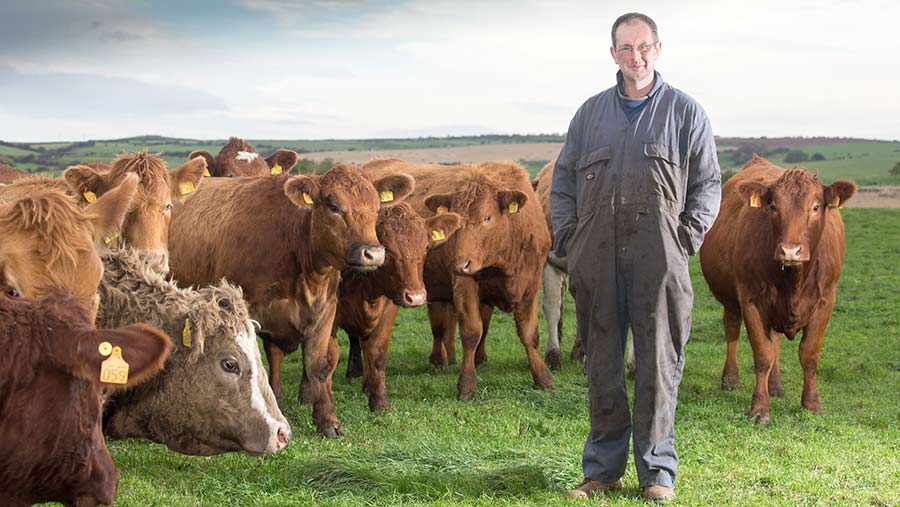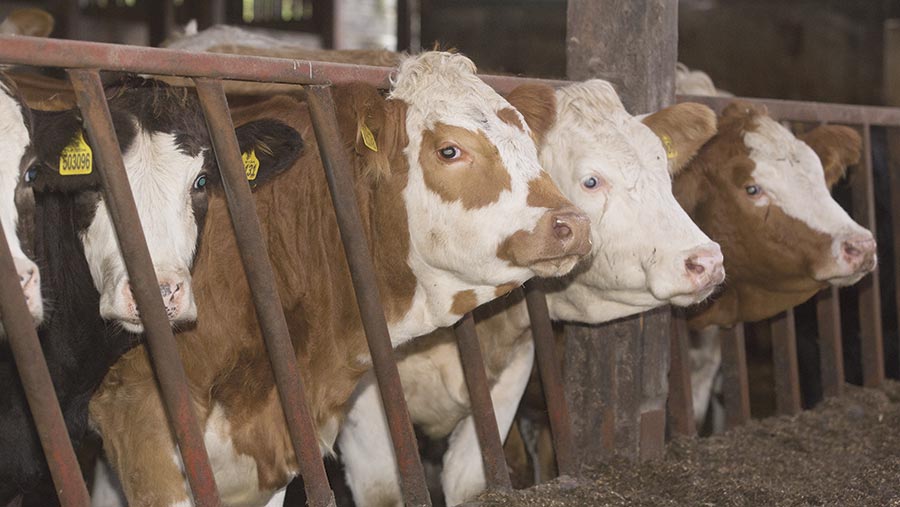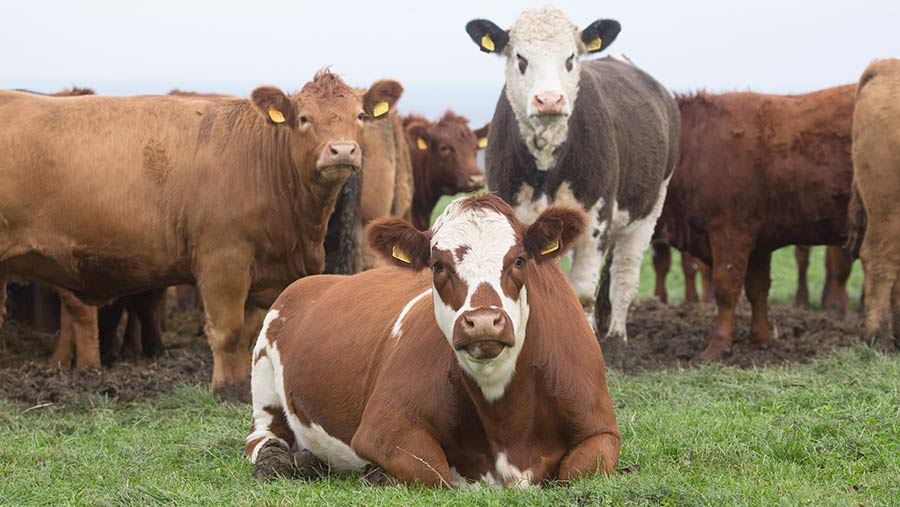Beef farm targets five herd KPIs to help cut costs
 © Tim Scrivener
© Tim Scrivener Grassland management and genetics are key focus areas for tenant farmer Guy Prudom, who wishes to reduce his cost of production/kg of liveweight from 328p/kg to 250p/kg.
Mr Prudom runs a commercial spring-calving suckler herd and arable enterprise on the edge of the North Yorkshire Moors.
Mr Prudom and his father Peter operated as organic farmers between 2007 and 2015 but have returned to conventional farming and are experimenting with crossbreeding over a Simental-cross cow.
They felt that organic premiums were not sufficient and stocking rates were a limiting factor, with the farm unable to provide enough muck to support soil fertility.
Angus and Simmental bulls will continue to be used, but more recently the Prudoms have bought a number of Stabiliser heifer replacements and two bulls.
See also: How a beef finisher keeps winter feed costs at 48p/day
Through consultation with the AHDB and independent consultants, led by farm business consultant Ian Cairns of Agrifood Technical Services, the Prudoms have identified five key performance indicators (KPIs) they can improve to help lift herd performance and profit.
“We became a strategic farm because expanding the arable side is difficult here and we need to improve the efficiency of the cattle, grassland management, genetics and feeding,” says Guy. “We’d like to finish more heifers in spec and make better use of data to cull cows not pulling their weight, and make the small year-on-year improvements that will leave us with the most efficient and hard-working cows.”
Northfields Farm, Whitby
- 200-head herd, mostly 3/4 Simmental sucklers
- 180-200ha (450-500 acres) arable Northfields Farm
- 200ha permanent pasture on Davison Farm, High Burrows Farm
- 3ha chicory, 2.5ha red clover to graze near farm and 16ha red clover in arable rotation
- Arable enterprise grows wheat, barley and winter beans
- Supplying Dovecote Farm on contract 280-360kg carcass
- Land is medium loam to heavier land
- All Mulgrave Estate farms
- Northfields has been managed by the Prudoms since Peter took on the tenancy 57 years ago
KPIs the Prudoms would like to improve |
|||
|
Herd KPI |
Performance |
Target |
How to hit target |
|
Cost of production for each kg of beef produced |
328p/kg |
250p/kg |
Increase kg of weaned calf |
|
Calves born |
90% |
95% |
Fertility testing, bulls bought on EBVs, calving ease, vaccination and health plan |
|
Cow efficiency (weaned calf weight as % of dam) |
44% |
50% |
Monitor mature cow size and weaning weights to influence heifer retainment and culling policy. Focus on calf growth rates to weaning – implement paddock grazing system |
|
Calves weaned |
85% |
90% |
Calf mortality low and not an issue, so this figure will be increased by addressing the calves born figure |
|
Carcasses in specification |
50% heifers and 75% steers |
80% overall |
Tighter calving block will help. Feed less cereal and more straw to heifers and reduce calving block from 10 to eight weeks in cows. |
Cost per kg of beef produced
Mr Cairns says the first step will be to maximise the total liveweight kg of calves weaned, thus sharing the fixed costs of the beef enterprise over more sales income.
“Future Strategic Farm meetings will enable us to consider strengths and weaknesses in the Farmbench figures then identify practical actions that can be taken to improve performance,” Mr Cairns explains.
Calves born
To increase the number of calves born alive, a key area will be reducing barren rate, currently at 11-12%.
Mr Prudom will source every bull on EBVs and semen test them. The whole herd will continue to be put through a health plan with Clevedale Vets, vaccinating for IBR, BVD and leptospirosis.
Measures to improve this are already in place, following a sub-fertile bull last year (missed 14 of 42 cows) and a case of IBR that lead to eight aborted calves in 2015.
IBR vaccination has been in place ever since, after the abortions lifted the ‘born dead’ rate from 3.5% to 8.5%.
Meanwhile, fertility on the dam side will be managed by monitoring BCS score and feeding straw in the ration as appropriate.
Herd records are managed through FarmPlan’s Cattle Manager software, which Guy says lacks the ability to record and track BCS and cow efficiency.
“This is where Cattle Manager lets us down,” says Guy. “Cow weights are going into Cattle Manager, so it’s just a case of it being able to calculate the percentage of weaned calf weight against each cow.”
Calves weaned
Calf mortality is below average at Northfields at 1.5-2% (average = 4%, AHDB Stocktake report, 2016). Mr Cairns believes the greatest improvement in calves weaned will come from having more calves born alive.
“Fertility testing all bulls every year and working with the vet on health plans and vaccination protocols will help,” he adds. “Liver fluke has surfaced as an issue recently so managing that appropriately with the right actives at the right time will also be important.
“Annual BVD herd testing and tag and testing calves is providing dividends. Managing BVD seems to be keeping other health issues at bay.”
Cow efficiency
Calves average 286kg liveweight (range 180-390kg) at weaning, with a range in cow efficiency between 24%-57% and calves hitting daily liveweight gains of 1.22kg/day on average.
Average cow weight is 651kg+ within the herd and overall weaning efficiency rate is 44% with calves weaned when they are 198 days old.

© Tim Scrivener
“Cow efficiency will be improved by monitoring cow size and weaning weights as well as boosting grass through a paddock grazing system,” Mr Cairns says.
“Moving away from the continental-cross and into the Stabiliser should help moderate cow size and, alongside better-quality grass, may see weaning weights hold or even improve slightly to lift cow efficiency.”
To improve grass quality and utilisation Guy Prudom will transition from one-week shifts between fields to a trial paddock grazing system, splitting 24ha into nine paddocks for a group of 50-60 cows and their spring-born calves.

© Tim Scrivener
Grassland productivity has been helped by soil testing every three years, and applying lime to lift pH levels from 5.5 to 6.5. Grass measuring with a plate meter and recording on Agrinet will also be implemented.
Mr Cairns says: “This could be one of the quick wins we see. It won’t cut fertiliser bills but it could lift calf DLWGs because it will increase the quality and consistency of dry matter available to the calves.”
Carcasses in specification
An issue with overfat heifers (4L) has meant about 50% have been out of specification.
Currently, heifers calve at 24 months in six to seven weeks and cows calve in 10, but the aim is to shorten the cow calving block by two weeks to improve calf uniformity.
More attention will be paid to straw inclusion rates in the rations and managing homegrown proteins, which includes wholecrop beans and red and white clover from the farm’s organic days.
We’ll re-visit the farm within the next 12 months to document their progress.
